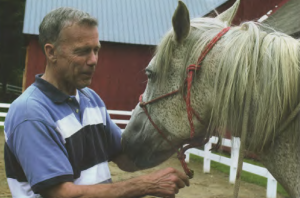Dick Reilly- legendary court builder and innovator
Platform tennis legend and Hall of Fame inductee, Dick Reilly has been a staple of the game for more than four decades. Growing up with the sport in Scarsdale, New York, Reilly remembers his father playing recreational platform tennis. Reilly took up the sport in college. After college, he entered the world of academia as a teacher, but worked on a construction crew, building houses in the off-months to supplement his income. It was during these summer vacations that Reilly got the idea that building platform tennis courts to a higher standard could do both him and the sport a service.
How did the idea to build platform tennis courts come to you?
“While playing on some courts in Scarsdale, I was shocked at how poorly the courts were made. In 1961, the wooden joints and butts of the platform were raised, causing many bad bounces. I thought that if I built a court, I would make the joints meet under the net. To do that, 30-foot boards would be required, but at that time, only 20- to 24- foot boards were made. Contracting a western lumber mill, I ordered a boxcar full of 2″x6″ x 30-foot boards, and that’s how we started. In my first year, I built two courts. At that time, there were no professional court builders and screens were pretty much nonexistent they were pretty much just a wire fence fastened to a 2×4-inch board. They were not taut. I increased the bottom boards to 3×4- inches, making them much stronger and able to hold much greater tension. In those days, the screens were still held together with staples. I can recall times when people would bump into the screens and actually fall through them. My solution was to interweave a lacing material, making the screens stronger and more playable.”
How did you come up with the concept to build platform tennis courts out of aluminum?
“Phil Osbourne was an engineer for Alcoa in New Jersey. Phil and I had a friend who just built the first aluminum tennis racquets at that time. He asked me to go to Princeton to build the first platform tennis court made of aluminum for George Vaughn and Dick Hardgrave, but I didn’t want to do it because I loved working with wood. That week, Phil and I designed the aluminum deck boards on a napkin at a local restaurant. He moved to Pittsburgh in the early ’60s, and along with Jenny Scott, built the Fox Chapel Racquet Club. He asked me again to build the first aluminum courts, using architectural blueprints which he helped create. We built the first aluminum court in November of 1963. We used a wooden superstructure to support the screens.”
Over the the years, how many courts did you build of wood and aluminum? And in what countries did you them?
“I built about 3,500 courts or so. Probably the first 100 were wood; the rest were all aluminum. It’s been a blessing that I’ve been able to travel the world putting in these courts. Many of the courts we’ve put in were in U.S. Embassies, such as those in Belgium, Moscow, Germany, Poland, England, France and Japan.”
“There must be close to 4,000 courts in existence today. The aluminum courts last forever. The old wooden decks would only last 7-8 years.”
When did your children get involved with the business? Are they involved full-time, part-time?
“Two of my four kids have been involved with the business, Jim and Kathy. They both graduated college in 1985, and I solicited them to get into the business. Kathy had a degree from Dartmouth and she was the perfect person to run the office. Jim had a degree in forestry, but I encouraged him to get into building the courts. At one time, Jim ran seven, two-man teams. Our business divided itself between building and maintenance. The wooden decks required tremendous maintenance, so we would hire college kids for summer resurfacing.”
You were an APTA board member in the 1980s. Can you contrast dynamics of the sport and Board at that time, with today?
“I recall when I was a Board Member in the ’80s, Mike North was the president of the APTA. The function of the APTA was primarily to set up tournaments, the Nationals being, of course, the biggest. Men’s and Women’s tournaments were divided by age and adolescent play began to grow.”
What are the greatest achievements of the APTA Board?
“I think the greatest achievements have been in branching the sport out to a national audience. Back in the ’70s and `80s, everything was at Fox Meadow and based along the East Coast. The first distant courts we built were at the Cincinnati Country Club. Phil Osbourne then helped us branch into Pittsburgh. Chicago came a bit later when we built Winnetka. John Embree was a big organizer for the sport in Chicago. The APTA has done so much for the sport.”
Did you ever meet the founders, James Cogswell or Fessenden Blanchard?
“Fessenden’s daughter, Ruth Walker, was our next door neighbor growing up. I was her yard man as a teenager. However, I never met Fessenden Blanchard. Over the years, I did meet James Cogswell several times, but he was not alive when we created the first aluminum courts. I think he would have been pleased with them.”
Source: Platform Tennis Magazine, Vol. 11, Issue 3, January, 2010





